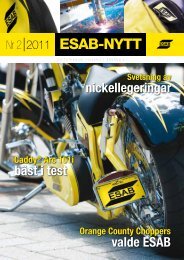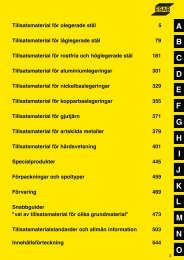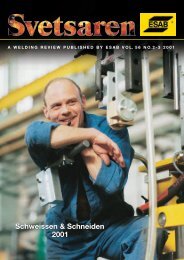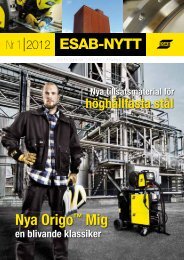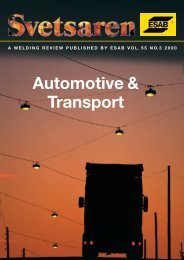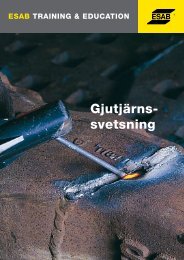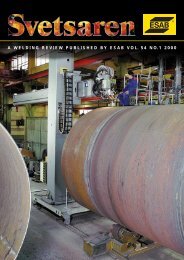FILARC flux - Esab
FILARC flux - Esab
FILARC flux - Esab
- No tags were found...
You also want an ePaper? Increase the reach of your titles
YUMPU automatically turns print PDFs into web optimized ePapers that Google loves.
<strong>FILARC</strong> <strong>flux</strong>- andmetal- coredwelding wiresHealth and safety, continuedContents page 4Previous pageNext pageHazards of excessive exposure towelding fumesEffects from excessive exposure to fumesarising from inadequate ventilation maybecome apparent at the time of welding,shortly afterwards, or at some later date.Some of the effects are summarised below,and here it is important to note that workersother than welders may also come into contactwith the products of welding fumes.Irritation of the respiratory tractThis is the effect of dust or fumes on thelining of the respiratory tract and can causedryness of the throat, tickling, coughing,chest tightness, wheezing and difficulty inbreathing. In its most acute form it cancause the lungs to become full of fluid. Theeffects will vary with exposure, concentrationand type of irritant.Metal fume feverThe inhalation of freshly formed metallicoxide such as those of zinc, chromium,nickel, copper and manganese may lead toan acute influenza-like illness termed metalfume fever.Systemic poisoningThis can result from inhalation or swallowingof substances such as fluorides, hexavalentchromium, lead and barium.Long term effectsCertain constituents of welding fumes, likehexavalent chromium, are carcinogenic.FibrosisThis is the formation of fibrous scar tissuein the lungs. It is the result of a reactionbetween dust or fumes with the lung tissue.There are various types depending on thenature of the substance involved and durationof exposure.In all cases of doubt concerning physicalresponse to welding pollutants, medicaladvice should be sought promptly.Fire/explosion hazardWelding consumables are not inflammableunder ordinary conditions and do normallynot present a fire or explosion risk. A fire orexplosion may result, however, when weldingis carried out in the presence of inflammable/explosivematerials.Atmospheric pollutantsIn any welding operation sources of atmosphericcontamination such as coatings,paint, oil, grease or de-greasing agents, maybe present in the welding zone, adding tothe fumes arising from weldingconsumables. Advice regarding the natureand extent of any hazard that might arisedirectly or indirectly from such substancesshould always be obtained from the manufacturerof these products.PrecautionsHazards from welding can be avoided bytaking adequate safety precautions.In providing welders and welding related personnelwith a safe working environment, fabricatorsare guided by national and internationalsafety standards and legislation, suchas The Health & Safety guidance note EH40"Occupational Exposure Limits", issued byThe Welding Manufacturers Association inthe UK.Most safety standards define safe workingconditions by specifying long term exposurelimits in mg/m 3 for the concentration ofa given type of welding fume in the air at awelding site, and, additionally, for the con-123



